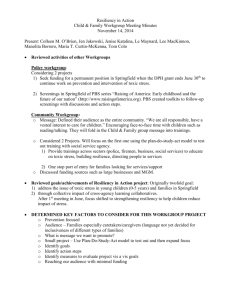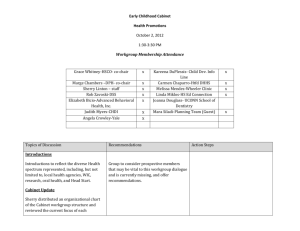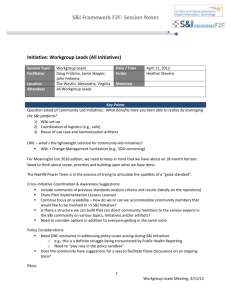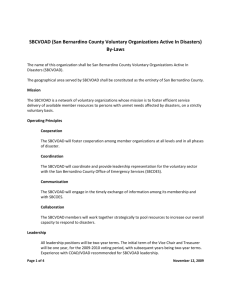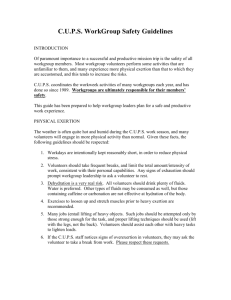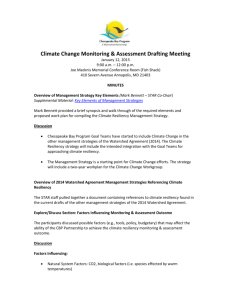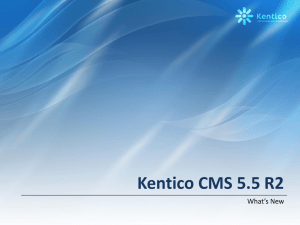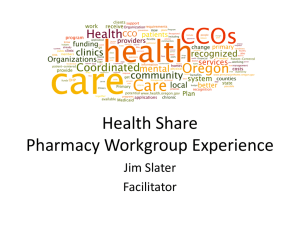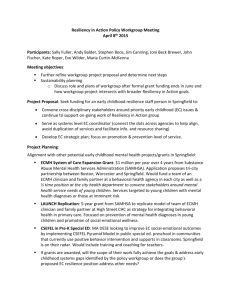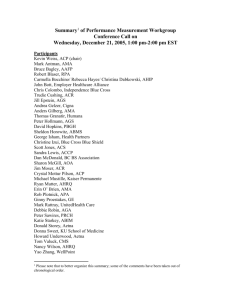December 16, 2014
advertisement
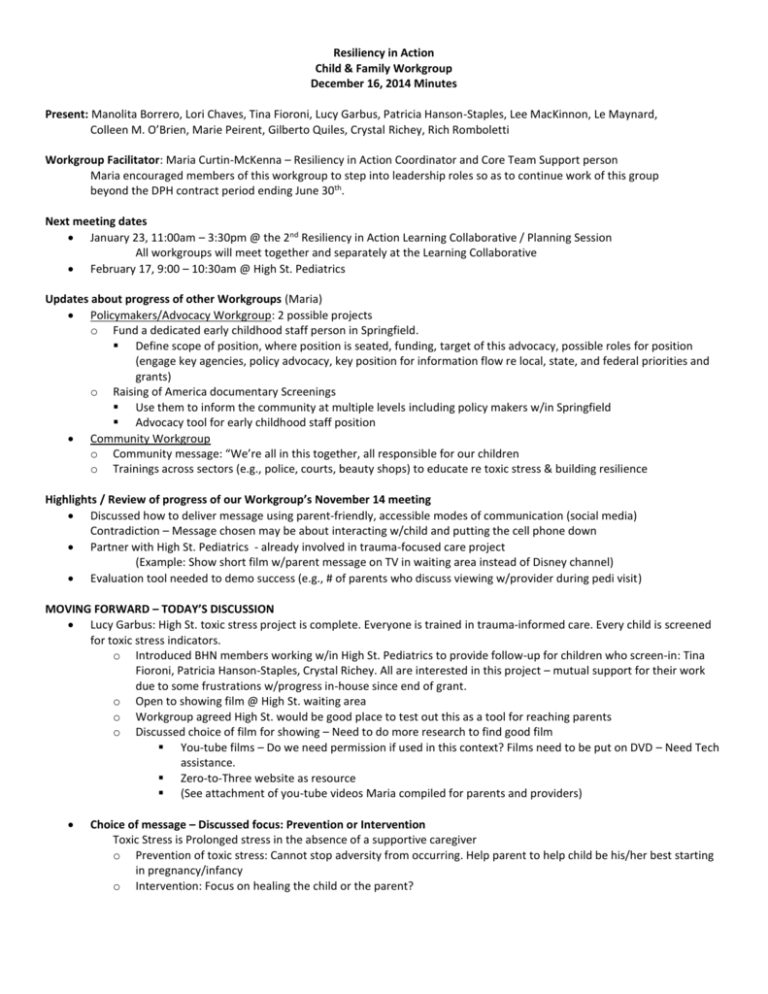
Resiliency in Action Child & Family Workgroup December 16, 2014 Minutes Present: Manolita Borrero, Lori Chaves, Tina Fioroni, Lucy Garbus, Patricia Hanson-Staples, Lee MacKinnon, Le Maynard, Colleen M. O’Brien, Marie Peirent, Gilberto Quiles, Crystal Richey, Rich Romboletti Workgroup Facilitator: Maria Curtin-McKenna – Resiliency in Action Coordinator and Core Team Support person Maria encouraged members of this workgroup to step into leadership roles so as to continue work of this group beyond the DPH contract period ending June 30th. Next meeting dates January 23, 11:00am – 3:30pm @ the 2nd Resiliency in Action Learning Collaborative / Planning Session All workgroups will meet together and separately at the Learning Collaborative February 17, 9:00 – 10:30am @ High St. Pediatrics Updates about progress of other Workgroups (Maria) Policymakers/Advocacy Workgroup: 2 possible projects o Fund a dedicated early childhood staff person in Springfield. Define scope of position, where position is seated, funding, target of this advocacy, possible roles for position (engage key agencies, policy advocacy, key position for information flow re local, state, and federal priorities and grants) o Raising of America documentary Screenings Use them to inform the community at multiple levels including policy makers w/in Springfield Advocacy tool for early childhood staff position Community Workgroup o Community message: “We’re all in this together, all responsible for our children o Trainings across sectors (e.g., police, courts, beauty shops) to educate re toxic stress & building resilience Highlights / Review of progress of our Workgroup’s November 14 meeting Discussed how to deliver message using parent-friendly, accessible modes of communication (social media) Contradiction – Message chosen may be about interacting w/child and putting the cell phone down Partner with High St. Pediatrics - already involved in trauma-focused care project (Example: Show short film w/parent message on TV in waiting area instead of Disney channel) Evaluation tool needed to demo success (e.g., # of parents who discuss viewing w/provider during pedi visit) MOVING FORWARD – TODAY’S DISCUSSION Lucy Garbus: High St. toxic stress project is complete. Everyone is trained in trauma-informed care. Every child is screened for toxic stress indicators. o Introduced BHN members working w/in High St. Pediatrics to provide follow-up for children who screen-in: Tina Fioroni, Patricia Hanson-Staples, Crystal Richey. All are interested in this project – mutual support for their work due to some frustrations w/progress in-house since end of grant. o Open to showing film @ High St. waiting area o Workgroup agreed High St. would be good place to test out this as a tool for reaching parents o Discussed choice of film for showing – Need to do more research to find good film You-tube films – Do we need permission if used in this context? Films need to be put on DVD – Need Tech assistance. Zero-to-Three website as resource (See attachment of you-tube videos Maria compiled for parents and providers) Choice of message – Discussed focus: Prevention or Intervention Toxic Stress is Prolonged stress in the absence of a supportive caregiver o Prevention of toxic stress: Cannot stop adversity from occurring. Help parent to help child be his/her best starting in pregnancy/infancy o Intervention: Focus on healing the child or the parent? o Decided that message can be both/and Parent Learns what is trauma and how to build resilience (Marie) Some parents do not know that they experienced abuse, were traumatized as children. May repeat their history w/out recognizing its impact on their child. (Lucy) One Child One Teacher – Pediatrician, Andy Garner: Chairperson, Early Brain and Childhood Development Leadership work Group. See article in Atlantic Monthly Magazine “How Supportive Parenting Protects the Brain” (http://www.theatlantic.com/health/archive/2014/06/how-supportive-parenting-protects-thebrain/373496/). Also published online as “The Not-so surprising secret to happy children: Parents who smile”) http://qz.com/227422/the-not-so-surprising-secret-to-happy-children-parents-whosmile/) and Youtube https://www.youtube.com/watch?v=TzHSxUUZPlk Parent Receives the message of the power of relationship through relationship with the person who is providing the message (pediatrician/nurse practitioner/ home visitor, etc.) Approach parents from positive perspective – not a pejorative one. o Toxic stress can have negative impact on brain development o Parents may be more open to hearing and motivated to change when message is about brainbuilding – ways they can build their child’s brain. Message: All workgroups are working on coming up with an “umbrella message” to promote to their audience Community Workgroup – Thought of possible message that uses image of parent and child looking at each other “Face 2 Face Time: There’s No App for that” Responsible Dissemination of message to parents Discussed screening of PPD as an example of issues to address and positive/negative consequences o Issues: Tools, scoring, discomfort of screeners, what to do after a child is screened in. o Positive: High St. partnered with MotherWoman to be trained in the Edinburgh Postpartum Depression Screener. o Negative: Experience of 1 committee person who received culturally insensitive screening by home visitor Once the message is out, need referral resources for adults and children who self-identify and/or need support and/or want to advocate for change Consistent access, continuation and follow-up through all avenues: doctor, schools, home visitors, funding Advocate for policy change - $ for pediatrician offices to screen, for follow-up child/parent therapy, to reduce sources of toxic stress. Evaluate the project: How do we demonstrate that what we do makes a difference? Ideas for disseminating umbrella message to parents T shirts w/message worn by High St. staff – Fun and encourage relationship – People will comment on it, ask what it’s about. (Talk about this and Grocery bags (What grocery stores are in Springfield? Markets? Posters – Pediatrician offices, buses, places where parents wait with their children o Talk about this with ____ and you get a . . . . Short-term - Long-term Members expressed wish that this was a longer grant period. If this was a 5-year grant, this project could be the groundwork Maria – Baby Steps are ok at this stage. We are using the Plan-Do-Study-Act model to test out a project, evaluate it, and expand. If the High St. project works well, Baystate may choose to promote it through their network. The hope is that there will be a continuation of efforts either through grant money to fund an Early Childhood position and/or because the Resiliency in Action workgroups choose to stay focused on this project. Follow-up Lucy and BHN – Will continue discussions w/High St. Pediatric about showing a video, youtube in waiting room Workgroup members: o Think of other ideas for disseminating the message to parents. o Research films for pediatrician waiting rooms that are short, easy to understand, about toxic stress and also ones that are positive, brain-building, about building relationship with their child
